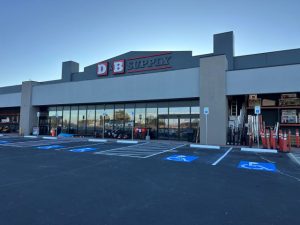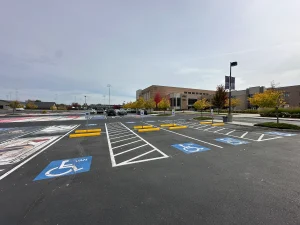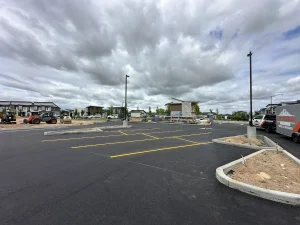Understanding Alligator Cracking and Why Crack Filling is Critical for Asphalt Maintenance
One of the most common and damaging types of asphalt pavement distress is alligator cracking. As the name suggests, alligator cracking refers to a series of interconnected cracks that resemble the scales on an alligator’s back. Left untreated, these cracks can lead to extensive pavement damage, higher repair costs, and safety hazards. Fortunately, crack filling is an effective way to address this issue early on, preventing further deterioration and prolonging the life of your asphalt surface. Here’s why understanding alligator cracking and the importance of crack filling is essential for maintaining your asphalt pavement.
1. What is Alligator Cracking?
Alligator cracking, also known as fatigue cracking, occurs when the asphalt surface weakens and breaks down under repeated stress. It often starts as small cracks that, over time, spread and form a web-like pattern. Alligator cracking typically results from one or more of the following factors:
- Heavy Traffic: Excessive weight from vehicles, especially heavy trucks, puts stress on the pavement, leading to cracking.
- Poor Drainage: Water that infiltrates the pavement can cause the underlying base to weaken, contributing to surface cracks.
- Subgrade Failure: A weak or improperly constructed subgrade layer (the material underneath the asphalt) can cause the asphalt to shift, resulting in cracking.
- Aging and Oxidation: Over time, asphalt becomes brittle due to sun exposure and oxidation, making it more susceptible to cracking under pressure.
Alligator cracking is a serious issue because it signals that the pavement structure is failing, not just on the surface but also in the underlying layers.
2. Why Crack Filling is Important
Crack Filling is the process of filling in cracks in the asphalt surface with a specialized sealant designed to prevent moisture, debris, and other elements from entering the cracks. When it comes to alligator cracking, addressing the problem early with crack filling is essential to preventing more extensive damage. Here’s why crack filling is a critical part of asphalt maintenance:
Prevents Water Infiltration
Water is one of the leading causes of asphalt damage. When cracks are left unsealed, water can seep into the pavement’s base and subgrade layers, weakening the foundation and leading to further cracking, potholes, and structural failure. Crack Filling acts as a barrier, keeping water out and protecting the integrity of the pavement.
Stops Cracks from Worsening
Once alligator cracking starts, it spreads quickly if not addressed. The more the pavement is exposed to vehicle traffic and weather conditions, the more extensive the cracking becomes. Crack filling halts the progression of cracks, preventing them from growing larger and more expensive to repair. Early intervention is key to extending the life of your asphalt.
Reduces Repair Costs
Neglecting small cracks leads to larger issues, such as potholes or the need for full-depth patching or resurfacing. Crack filling is a cost-effective maintenance solution that addresses problems early, avoiding the need for more expensive repairs down the line. By investing in crack filling now, property owners can save significantly on future repair and replacement costs.
Improves Safety
Alligator cracking can create hazardous conditions for both vehicles and pedestrians. Uneven surfaces, potholes, and debris can increase the risk of accidents, trips, and falls. Crack filling smooths out the surface and prevents further deterioration, creating a safer environment for everyone using the pavement.
Enhances Aesthetic Appeal
Cracked, damaged asphalt can make a parking lot or driveway look neglected and unprofessional. Crack Filling helps restore the smooth appearance of the asphalt surface, improving the overall curb appeal of your property. This is especially important for businesses, where first impressions matter.
3. When to Crack Fill Alligator Cracking
It’s important to note that crack filling is most effective when the cracking is caught early. Once alligator cracking becomes severe, with deep cracks or extensive structural failure, more extensive repairs such as patching or complete resurfacing may be necessary. Regular inspections and proactive maintenance are essential to identifying and addressing cracks before they worsen.
Here’s a general guide to when crack filling is appropriate:
- Small Cracks: If alligator cracking is in its early stages and consists of small, surface-level cracks, crack filling is usually sufficient to prevent further damage.
- Moderate Cracks: If the cracks are moderate but the subgrade is still intact, crack filling combined with sealcoating can restore the pavement’s appearance and functionality.
- Severe Cracks: If the cracks are deep and the underlying structure is compromised, more intensive repairs, such as full-depth patching or resurfacing, may be required.
4. The Role of Sealcoating in Preventing Alligator Cracking
While crack filling is crucial for repairing existing damage, sealcoating plays a complementary role in preventing future cracking. Sealcoating adds a protective layer to the asphalt surface, shielding it from UV rays, oxidation, and moisture. Regularly scheduled sealcoating helps keep the surface flexible and strong, reducing the risk of cracking in the first place.
Conclusion
Alligator cracking is more than just an eyesore—it’s a serious sign of asphalt deterioration that requires immediate attention. Crack filling is an essential part of asphalt maintenance, providing a cost-effective and efficient way to prevent further damage, protect your investment, and ensure the safety of your pavement. By addressing alligator cracking early with crack filling and incorporating regular maintenance practices like sealcoating, you can extend the life of your asphalt and avoid expensive repairs down the road.


